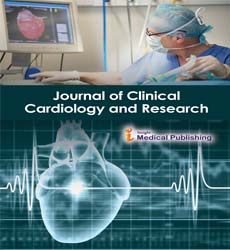Case Report on Clinical and Echocardiographic Identification of Congenital Cardiac Malformation
Erin Sophia
Department of Cardiology, University of California, San Francisco, San Francisco, California
Corresponding author:
Erin Sophia,
Department of Cardiology, University of California, San Francisco, San Francisco, California;
Email: erin@sophia.edu
Received date: January 01, 2025, Manuscript No. ipccr-25-20605; Editor assigned date: January 03, 2025, PreQC No. ipccr-25-20605 (PQ); Reviewed date: January 15, 2025, QC No. ipccr-25-20605; Revised date: January 22, 2025, Manuscript No. ipccr-25-20605 (R); Published date: January 28, 2025, DOI: 10.36648/.8.1.2
Citation: Sophia E (2025) Case Report on Clinical and Echocardiographic Identification of Congenital Cardiac Malformation. J Clin Cardiol Res Vol.8 No.1:2
Abstract
Introduction
Congenital cardiac malformations are structural anomalies of the heart and great vessels that arise during embryonic development and are among the most common congenital disorders worldwide. These conditions include ventricular septal defects, atrial septal defects, tetralogy of Fallot, anomalous pulmonary venous return, and transposition of the great arteries. Early diagnosis is critical, as patients may present with symptoms ranging from asymptomatic murmurs to cyanosis, heart failure, or recurrent respiratory infections. Radiology, particularly echocardiography and computed tomography (CT), plays a central role in detecting and characterizing these abnormalities, which are vital for clinical decision-making and surgical planning [1].Description
This case report presents the diagnostic evaluation of a patient with a congenital cardiac malformation, emphasizing the pivotal role of imaging in reaching a definitive diagnosis. A pediatric patient presented with recurrent lower respiratory tract infections, exertional dyspnea, and a persistent cardiac murmur noted on clinical examination. Chest X-ray demonstrated cardiomegaly with increased pulmonary vascular markings, raising the suspicion of a congenital heart defect. Transthoracic echocardiography revealed an abnormal communication between the left atrium and right atrium, suggesting a secundum Atrial Septal Defect (ASD) [2]. To further assess the defect, cardiac CT angiography was performed, which confirmed the presence of a large ASD with right atrial and right ventricular enlargement, along with evidence of left-to-right shunting Imaging was also crucial in differentiating this lesion from other congenital anomalies such as partial anomalous pulmonary venous return (PAPVR) or Ventricular Septal Defect (VSD) While PAPVR is typically identified by anomalous venous drainage into the right atrium or vena cava [3]. VSD involves interventricular communication, the absence of anomalous venous return and interventricular defects supported the diagnosis of ASD. This precise radiological differentiation helped guide the clinical team toward an appropriate treatment pathway. The role of imaging extended into treatment planning. Detailed visualization of cardiac chambers, shunt size, and pulmonary artery pressures informed the decision for surgical closure. Postoperative echocardiography confirmed successful closure of the defect and normalization of right heart chamber dimensions [4]. The patient showed significant clinical improvement, with resolution of respiratory symptoms and enhanced exercise tolerance. Furthermore, the incorporation of advanced imaging into both pre- and postoperative phases underscored its pivotal role in guiding therapeutic precision and monitoring recovery. By delineating anatomical and functional changes, imaging not only validated surgical success but also provided a baseline for long-term follow-up. Periodic echocardiography and CT evaluations ensured early identification of residual shunts, postoperative complications, or evolving pulmonary vascular changes This structured imaging pathway reinforced the value of integrating radiological insights into multidisciplinary care, where cardiologists, radiologists, and surgeons collectively interpret findings to optimize patient outcomes and sustain long-term cardiopulmonary stability. [5].Conclusion
This case highlights the indispensable role of radiology in diagnosing congenital cardiac malformations. Echocardiography, complemented by cardiac CT angiography, provides critical structural and functional information, enabling accurate classification, differentiation from overlapping anomalies, and guidance for surgical intervention. Early and precise radiological identification of congenital cardiac defects is essential for optimal patient outcomes, underscoring the value of imaging in modern cardiology practice.References
- Liuzzo G, Biasucci LM, Gallimore JR, Grillo RL, Rebuzzi AG, et al. (1994) The prognostic value of C-reactive protein and serum amyloid A protein in severe unstable angina. N Engl J Med 331: 417–424
Google Scholar Cross Ref Indexed at
- Chatterjee TK, Stoll LL, Denning GM, Harrelson A, Blomkalns AL, et al. (2009) Proinflammatory phenotype of perivascular adipocytes: Influence of high-fat feeding. Circ Res 104: 541–549
Google Scholar Cross Ref Indexed at
- Okamoto E, Couse T, De Leon H, Vinten-Johansen J, Goodman RB, et al. (2001) Perivascular inflammation after balloon angioplasty of porcine coronary arteries. Circulation 104: 2228–2235
Google Scholar Cross Ref Indexed at
- Greenstein AS, Khavandi K, Withers SB, Sonoyama K, Clancy O, et al. (2009) Local inflammation and hypoxia abolish the protective anticontractile properties of perivascular fat in obese patients. Circulation 119: 1661–1670
Google Scholar Cross Ref Indexed at
- Diaba-Nuhoho P, Mittag J, Brunssen C, Morawietz H, Brendel H (2024) The vascular function of resistance arteries depends on NADPH oxidase 4 and is exacerbated by perivascular adipose tissue. Antioxidants 13: 503
Open Access Journals
- Aquaculture & Veterinary Science
- Chemistry & Chemical Sciences
- Clinical Sciences
- Engineering
- General Science
- Genetics & Molecular Biology
- Health Care & Nursing
- Immunology & Microbiology
- Materials Science
- Mathematics & Physics
- Medical Sciences
- Neurology & Psychiatry
- Oncology & Cancer Science
- Pharmaceutical Sciences
